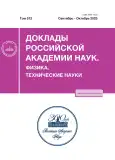RAMAN-GEOTHERMOMETER FOR CARBONACEOUS CHONDRITES
- Autores: Voropaev S.А.1, Krivenkо A.P.1, Dushenkо N.V.1
-
Afiliações:
- Vernadsky Institute of Geochemistry and Analytical Chemistry of the Russian Academy of Sciences
- Edição: Volume 512, Nº 1 (2023)
- Páginas: 69-72
- Seção: ТЕХНИЧЕСКИЕ НАУКИ
- URL: https://journals.rcsi.science/2686-7400/article/view/232981
- DOI: https://doi.org/10.31857/S2686740023050139
- EDN: https://elibrary.ru/HWLJXD
- ID: 232981
Citar
Texto integral
Resumo
Samples of the Murchison meteorite (carbonaceous chondrite, type CM2) were kept isothermally in a specially designed device at temperatures of 200, 500 and 800°C. After the samples cooled down in an inert helium atmosphere, Raman scattering spectra were taken. An increase in the intensity of the G- and D-lines of graphite was detected depending on the degree of heating. It is shown that using such a characteristic parameter of these lines as the area ratio, SD/SG, it is possible to define a geothermometer to determine the maximum temperature of thermal metamorphism of the parent bodies of carbonaceous chondrites. A comparison with the known data for carbonaceous chondrite Allende (CM3), which has experienced a significant thermal metamorphism, is carried out.
Palavras-chave
Sobre autores
S. Voropaev
Vernadsky Institute of Geochemistry and Analytical Chemistry of the Russian Academy of Sciences
Autor responsável pela correspondência
Email: voropaev@geokhi.ru
Russia, Moscow
A. Krivenkо
Vernadsky Institute of Geochemistry and Analytical Chemistry of the Russian Academy of Sciences
Email: voropaev@geokhi.ru
Russia, Moscow
N. Dushenkо
Vernadsky Institute of Geochemistry and Analytical Chemistry of the Russian Academy of Sciences
Email: voropaev@geokhi.ru
Russia, Moscow
Bibliografia
- Маров М.Я., Ипатов С.И. Процессы миграции в Солнечной системе и их роль в эволюции Земли и планет // УФН. 2023. Т. 193. С. 2–32.
- Tuinstra F., Koenig J.L. Raman spectrum of graphite // J. Chemical Physics. 1970. V. 53. P. 1126–1130.
- Wopenka B., Pasteris J.D. Structural characterization of kerogens to granulite-facies graphite: Applicability of Raman microprobe spectroscopy // American Mineralogist. 1993. V. 78. P. 533–557.
- Воропаев С.А., Душенко Н.В., Федулов В.С., Сенин В.Г. Особенности дегазации азота хондрита Dhajala (H3.8) // Доклады РАН. Физика, технические науки. 2023. Т. 509. № 2. С. 20–26.
- Voropaev S., Boettger U., Pavlov S., Hanke F., Petukhov D. Raman spectra of the Markovka chondrite (H4) // J. Raman spectroscopy. 2021. P. 1–9. https://doi.org/10.1002/jrs.6147
- Botta O., Bada J. Extraterrestrial organic compounds in meteorites // Surveys in Geophysics. 2002. V. 23. P. 411–467.
- Zolensky M., Barrett R., and Browning L. Mineralogy and composition of matrix and chondrule rims in carbonaceous chondrites // Geochim. Cosmochim. Acta. 1993. V. 57. P. 3123–3148.
- Krot A.N., Scott E.R.D., Zolensky M.E. Mineralogic and chemical variations among CV3 chondrites and their components: Nebular and asteroidal processing // Meteoritics. 1995. V. 30. P. 748–775.
- Busemann H., Alexander C., Nittler L. Characterization of insoluble organic matter in primitive meteorites by micro Raman spectroscopy // Meteoritics & Planetary Science. 2007. V. 42 (7/8). P. 1387–1416.
- Schultz P.H. et al. The LCROSS Cratering Experiment // Science. 2010. V. 330. P. 468–472.
Arquivos suplementares













